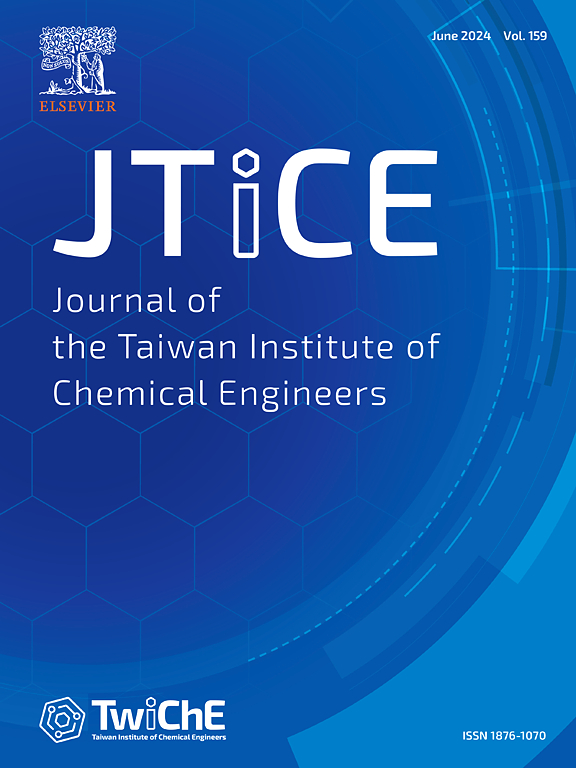电磁屏蔽和电热用Ni/ co涂层碳纤维的设计、建模和多响应优化
IF 5.5
3区 工程技术
Q1 ENGINEERING, CHEMICAL
Journal of the Taiwan Institute of Chemical Engineers
Pub Date : 2025-04-01
DOI:10.1016/j.jtice.2025.106116
引用次数: 0
摘要
背景磁性纳米粒子涂层碳纤维因其电磁干扰(EMI)屏蔽应用而吸引了大量研究。方法采用响应面法(RSM)研究了沉积时间(60-180 s)和电流密度(2-6 A/dm2)对镍/钴负载量、电导率和屏蔽效果(SE)的影响。重要发现电流密度对屏蔽效果的影响与电镀时间的影响相反,随着电流从 2 A/dm2 增加到 4 A/dm2 ,屏蔽效果值首先得到提高,然后,随着电流密度从 4 A/dm2 增加到 6 A/dm2 ,屏蔽效果达到最低水平。在电镀时间为 180 秒、电流密度为 3.2 A/dm2 时,选择了最佳样品。最佳样品的镍/钴负载量、导电率和 SE 分别为 6.15 ± 0.11 %、625.64 ± 39.55 S/cm 和 63.8 ± 0.8 dB。电热结果表明,电压从 0.7 V 到 3.4 V 的变化导致优化样品的温度从 32.0 ℃ 到 286.0 ℃ 的变化,从而使这种织物对特定应用具有吸引力。本文章由计算机程序翻译,如有差异,请以英文原文为准。

Designing, modeling, and multi-response optimization of Ni/Co-coated carbon fibers for electromagnetic shielding and electrothermal applications
Background
Magnetic nanoparticle-coated carbon fibers have attracted lots of research for their electromagnetic interference (EMI) shielding applications. This research is focused on optimizing the coating process of Ni/Co alloy nanoparticles on carbon fiber surfaces to achieve suitable properties including electrical conductivity, EMI shielding, and electrothermal.
Methods
The effects of deposition time (60–180 s) and current density (2–6 A/dm2) on Ni/Co loading amount, electrical conductivity, and shielding effectiveness (SE) are investigated using the response surface method (RSM). By using the RSM method, a mathematical model is introduced for each of the parameters of load value results, electrical conductivity, and SE and this model is validated with statistical methods.
Significant findings
The current density, contrary to the effect of plating time, SE value first developments with the increase of the current from 2 A/dm2 to 4 A/dm2, Then, by increasing the current density from 4 A/dm2 to 6 A/dm2, SE reaches its lowest level. The optimal sample is selected with a plating time of 180 s and a current density of 3.2 A/dm2. The amount of Ni/Co loading, electrical conductivity, and SE of the optimal sample are 6.15 ± 0.11 %, 625.64 ± 39.55 S/cm, and 63.8 ± 0.8 dB, respectively. The electrothermal results show that voltage changes from 0.7 to 3.4 V lead to optimized sample temperature changes from 32.0 to 286.0 °C, thus making this fabric attractive for specific applications.
求助全文
通过发布文献求助,成功后即可免费获取论文全文。
去求助
来源期刊
CiteScore
9.10
自引率
14.00%
发文量
362
审稿时长
35 days
期刊介绍:
Journal of the Taiwan Institute of Chemical Engineers (formerly known as Journal of the Chinese Institute of Chemical Engineers) publishes original works, from fundamental principles to practical applications, in the broad field of chemical engineering with special focus on three aspects: Chemical and Biomolecular Science and Technology, Energy and Environmental Science and Technology, and Materials Science and Technology. Authors should choose for their manuscript an appropriate aspect section and a few related classifications when submitting to the journal online.

 求助内容:
求助内容: 应助结果提醒方式:
应助结果提醒方式:


